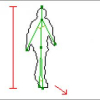Free Online Productivity Tools
i2Speak
i2Symbol
i2OCR
iTex2Img
iWeb2Print
iWeb2Shot
i2Type
iPdf2Split
iPdf2Merge
i2Bopomofo
i2Arabic
i2Style
i2Image
i2PDF
iLatex2Rtf
Sci2ools
ICPR
2004
IEEE
2004
IEEE
Human Action Segmentation via Controlled Use of Missing Data in HMMs
Segmentation of individual actions from a stream of human motion is an open problem in computer vision. This paper approaches the problem of segmenting higher-level activities into their component sub-actions using Hidden Markov Models modified to handle missing data in the observation vector. By controlling the use of missing data, action labels can be inferred from the observation vector during inferencing, thus performing segmentation and classification simultaneously. The approach is able to segment both prominent and subtle actions, even when subtle actions are grouped together. The advantage of this method over sliding windows and Viterbi state sequence interrogation is that segmentation is performed as a trainable task, and the temporal relationship between actions is encoded in the model and used as evidence for action labelling.
| Added | 09 Nov 2009 |
| Updated | 09 Nov 2009 |
| Type | Conference |
| Year | 2004 |
| Where | ICPR |
| Authors | Patrick Peursum, Hung Hai Bui, Svetha Venkatesh, Geoff A. W. West |
Comments (0)

